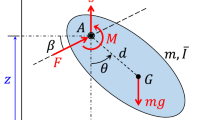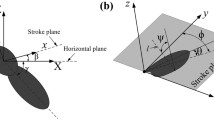Summary
-
1.
The hindwing movements and flight motor pattern underlying straight flight and negative phonotactic steering of the cricketTeleogryllus oceanicus were investigated by photographing the wing movements and by recording electromyograms (EMG) from hindwing muscles.
-
2.
During straight flight the right and left hindwings showed symmetrical strokes. When the animal turned in response to ultrasonic auditory stimuli the wing stroke was clearly asymmetrical. For animals tethered in an inverted position the hindwing outside the turn showed a lower elevation than the hindwing inside the turn.
-
3.
The straight flight motor pattern showed the elevators were active at 45 to 57% of the depressor cycle. The latency from depressor to elevator activity (D-E) showed a positive correlation with the depressor period whereas the latency from elevator to depressor activity (E-D) was relatively independent of the depressor period.
-
4.
The wing beat frequency increased when the animal steered in response to auditory stimuli.
-
5.
During steering of an animal tethered in an inverted position the elevator muscles on the inside of a turn showed increased activity (double spikes). Also, on the inside of a turn the latency from depressor to elevator activity decreased and the phase of elevator activity in the depressor cycle decreased. On the outside of a turn the elevator muscles were less active. The latency from depressor to elevator activity increased as did the phase of elevator activity in the depressor cycle.
-
6.
The increased activity and earlier firing of the elevators on the inside of a turn is consistent with a greater wing elevation on the same side. Similarly, the decreased activity and later firing of the elevator on the outside of a turn is consistent with a lower wing elevation on that side. These asymmetrical wing strokes seen in the hindwing could be important elements of steering.
Similar content being viewed by others
Abbreviations
- D :
-
depressor
- D-E :
-
latency of depressor to elevator activity;
- E :
-
elevator
- E-D :
-
latency of elevator to depressor activity
- EMG :
-
electromyogram
References
Atkins G, Pollack GS (1987) Correlations between structure, topographic arrangement, and spectral sensitivity of soundsensitive interneurons in crickets. J Comp Neurol 266:398–412
Baker PS (1979a) The wing movements of flying locusts during steering behaviour. J Comp Physiol 131:49–58
Baker PS (1979b) The role of forewing muscles in the control of direction in flying locusts. J Comp Physiol 131:59–66
Bentley DR (1973) Postembryonic development of insect motor systems. In: Young D (ed) Developmental neurobiology of Arthropods. Cambridge University Press, London, pp 147–177
Bentley DR, Hoy RR (1970) Postembryonic development of adult motor patterns in crickets: a neural analysis. Science 170:1409–1411
Camhi JM (1970) Yaw-correcting postural changes in locusts. J Exp Biol 52:519–531
Cooter RJ (1979) Visually induced yaw movements in flying locust,Schistocerca gregaria. J Comp Physiol 131:67–78
Doolan JM, Pollack GS (1985) Phonotactic specificity of the cricketTeleogryllus oceanicus: intensity-dependent selectivity for temporal parameters of the stimulus. J Comp Physiol A 157:223–233
Dugard JJ (1967) Directional change in flying locusts. J Insect Physiol 13:1055–1063
Eibl E, Huber F (1979) Central projections of tibial sensory fibers within the three thoracic ganglia of crickets (Gryllus campestris L.,Gryllus bimaculatus) DeGeer. Zoomorphologie 92:1817
Elson R (1986) The activity of a steering muscle in flying locusts. J Exp Biol 120:421–441
Furukawa N, Tomioka K, Yamaguchi T (1983) Functional anatomy of the musculature and innervation of the neck and thorax in the cricket,Gryllus bimaculatus. Zool Mag 92:371–385
Gettrup E (1966) Sensory regulation of wing twisting in locusts. J Exp Biol 44:1–16
Horn E, Bischof H (1983) Gravity reception in crickets: the influence of cercal and antennal afferences on the head position. J Comp Physiol 150:93–98
Jensen M (1956) Biology and physics of locust flight. III. The aerodynamics of locust flight. Phil Trans R Soc Lond B 239:511–552
May ML, Brodfuehrer PD (1987) Changes in wing parameters inTeleogryllus oceanicus due to ultrasonic stimuli. Soc Neurosci Abstr 13:398
Möhl B, Zarnack W (1977) Activity of the direct downstroke flight muscles ofLocusta migratoria (L.) during steering behavior in flight. II. Dynamics of the time shift and changes in the burst length. J Comp Physiol 118:235–247
Moiseff A, Pollack GS, Hoy RR (1978) Steering responses of flying crickets to sound and ultrasound: mate attraction and predator avoidance. Proc Natl Acad Sci USA 75:4052–4056
Nolen TG, Hoy RR (1986a) Phonotaxis in flying crickets. I. Attraction to the calling song and avoidance of bat-like ultrasound are discrete behaviors. J Comp Physiol A 159:423–439
Nolen TG, Hoy RR (1986b) Phonotaxis in flying crickets. II. Physiological mechanisms of two-tone suppression of the high frequency avoidance steering behavior by the calling song. J Comp Physiol A 159:441–456
Pollack GS, Hoy RR (1981) Phonotaxis in flying crickets: neural correlates. J Insect Physiol 27:41–45
Pollack GS, Plourde N (1982) Directionality of acoustic orientation in flying crickets. J Comp Physiol 146:207–215
Pollack GS, Huber F, Weber T (1984) Frequency and temporal pattern dependent phonotaxis ofTeleogryllus oceanicus in flight and walking paradigms. J Comp Physiol A 154:13–26
Popov AV, Shuvalov VF (1977) Phonotactic behavior of crickets. J Comp Physiol 119:111–126
Popov AV, Shuvalov VF, Markovich AM (1975) Spectrum of the calling songs, phonotaxis and the auditory system in the cricketGryllus bimaculatus. J Evol Biochem Physiol 2:453–460
Robertson RM (1987) Interneurons in the flight system of the cricketTeleogryllus oceanicus. J Comp Physiol A 160:431–445
Rosner B (1982) Fundamentals of biostatistics. Duxbury Press, Boston
Sakaguchi OS, Murphey RK (1983) The equilibrium detecting system of the cricket: physiology and morphology of an identified interneuron. J Comp Physiol 150:141–152
Stevenson PA, Kutsch W (1987) A reconsideration of the central pattern generator concept for locust flight. J Comp Physiol A 161:115–129
Taylor CP (1981) Contributions of compound eyes and ocelli to steering of locusts in flight II. Timing changes in flight motor units. J Exp Biol 93:19–31
Thüring DA (1986) Variability of motor output during flight steering in locusts. J Comp Physiol A 158:653–664
Tomioka K, Yamaguchi T (1980) Steering responses of adult and nymphal crickets to light, with special reference to the head rolling movement. J Insect Physiol 26:47–57
Waldron I (1967) Neural mechanisms by which controlling inputs influence motor output in the flying locust. J Exp Biol 47:213–228
Wilson DM (1968) Inherent asymmetry and reflex modulation of the locust flight motor pattern. J Exp Biol 48:631–641
Wilson DM, Weis-Fogh T (1962) Patterned activity of coordinated motor units, studied in flying locusts. J Exp Biol 39:643–667
Wohlers DW, Huber F (1985) Topographical organization of the auditory pathway within the prothoracic ganglion of the cricketGryllus campestris L. Cell Tiss Res 239:555–565
Zarnack W, Möhl B (1977) Activity of the direct downstroke flight muscles ofLocusta migratoria (L.) during steering behaviour in flight I. Patterns of time shift. J Comp Physiol 118:215–233
Author information
Authors and Affiliations
Rights and permissions
About this article
Cite this article
Wang, S., Robertson, R.M. Changes of the hindwing motor pattern associated with phonotactic steering during flight in the cricket,Teleogryllus oceanicus . J. Comp. Physiol. 164, 219–229 (1988). https://doi.org/10.1007/BF00603952
Accepted:
Issue Date:
DOI: https://doi.org/10.1007/BF00603952




